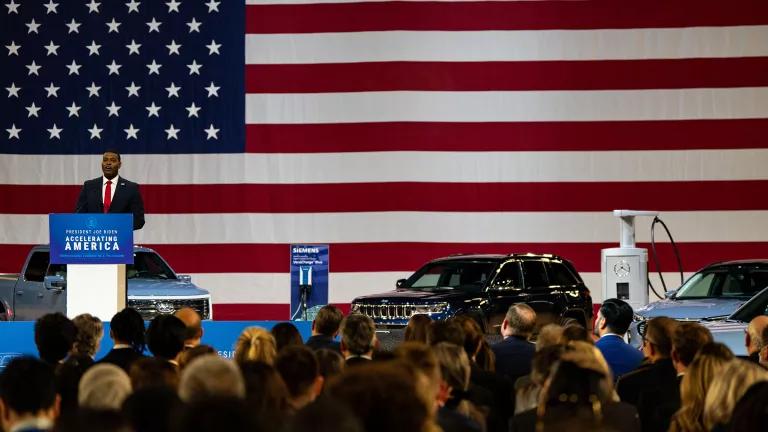Chicago City Council Votes for Equitable Access to EVs

This blog was co-authored with Mary Nicol, Climate Advisor to the City of Chicago.
Some good news for cleaner air: the City of Chicago is taking decisive steps to ensure it is a hub for electric vehicles (EVs). The City Council today passed an ordinance strengthening requirements for EV readiness at commercial and residential buildings, promoting more equitable access to this emerging technology throughout the city.
The ordinance tightens EV charging requirements for parking lots of new developments. These requirements include increasing the number of parking spaces that must have EV charging infrastructure available (20% of total parking spaces), heightening the level of EV charging infrastructure that must be installed, and expanding the number of new developments to which the policy applies.
Why EV Readiness Is Good for Chicago’s Economy
There are several reasons to standardize EV readiness for buildings, but one of the biggest is reduced costs for EV owners and building owners. EV owners save money because they will not have to pay extra to install charging infrastructure in order to charge their cars at home. With more and more Chicagoans driving electric, it’s clear that demand for EV charging, both at home and at commercial businesses, will only increase with time. That’s where the cost savings for building owners come in: it’s thousands of dollars cheaper to install EV charging infrastructure when a building is first constructed than to retrofit the building later.
What’s in the Ordinance
Aldermen Brendan Reilly & Matthew Martin proposed a stronger EV readiness ordinance in October 2019 after a more relaxed version passed Chicago City Council the previous month. They enhanced their proposal even further by introducing a substitute ordinance in March 2020, which was approved today. The newest ordinance has a few key differences, especially regarding thresholds for EV charging requirements among new residential and commercial buildings.
To ensure more residential and commercial buildings are supporting EV charging, the thresholds for requiring installation of charging infrastructure were decreased. Now, residential buildings with five or more dwelling units (reduced from 24) and commercial buildings with 30 or more parking spaces (reduced from 50) must have EV charging infrastructure installed in their parking lots.
Additionally, these buildings must install EV-ready (Level 2) or EV-installed (Level 3) infrastructure during construction. “EV-ready” means that a parking spot will have the electrical panel capacity, circuit, conduit, wiring, and outlet necessary for future installation of an EV charging station, while “EV-installed” takes it a step further by incorporating the actual charging station.
These threshold reductions and EV level requirements will lower a key entry barrier for potential EV drivers by enabling EV drivers to easily charge their vehicles at home or at work. As of now, the ordinance does not apply to existing buildings. However, as more people come to understand the significant health and financial benefits of EVs, we anticipate that communities will continue to demand EV readiness as a standard for all buildings across the United States.
The new ordinance opens the electric vehicle market to more than just early adopters. By creating a more EV-friendly environment, Chicago residents from all income levels will see reduced barriers to entry in the EV market. At home EV charging infrastructure can cost an EV owner as much as an additional $7,210, making EVs an unattractive option for a typical mid-income buyer. By creating stricter requirements for building owners on EV charging, the cost of owning and maintaining an electric vehicle will be greatly reduced.
Ensuring EV charging infrastructure is set up in new buildings reduces the overall costs for both building owners and potential EV buyers. This is a huge step in ensuring equity remains an important factor for climate action policy in a city that is historically divided in income, race, and life expectancy. Lowering the cost to charge an EV makes it a more attractive option, and in turn, allows vehicle owners to save more money over time on gas. With rebates and the option of buying used, the price of an EV can be comparable to a gas-powered vehicle.
The Need for Strong State and City EV Policy
It’s not just Chicago aldermen focused on getting more EVs on the road: the Illinois Clean Energy Jobs Act (CEJA) focuses on the impact of transportation on carbon emissions, even creating “EV Access For All,'' to ensure more people have access to EVs through car-sharing and electric shuttles in transit deserts. It also creates an incentive to produce EV-ready infrastructure across the state to support expanding EV needs. Overall, CEJA is working to support EV access - especially in lower-income communities - and remove 1 million gas-powered vehicles from the road.
Chicago has one of the largest carbon footprints globally. The city is ranked eighth in the world for its carbon footprint, with over 31 million metric tons of climate-warming emissions released annually according to the city’s latest Greenhouse Gas (GHG) Inventory Report. While this ordinance will not reduce Chicago’s emissions overnight, its passage is a major step in clean energy investment and innovation, allowing the city to eventually make a big difference in carbon emissions reductions. This very closely aligns with the city's Climate Action Plan and goal to achieve net-zero carbon emissions by 2050.
With this ordinance, and as a part of the American Cities Climate Challenge, Chicago exemplifies its leadership in equitable climate action and sets an example for cities looking to implement policy focused on clean air and renewable energy.



